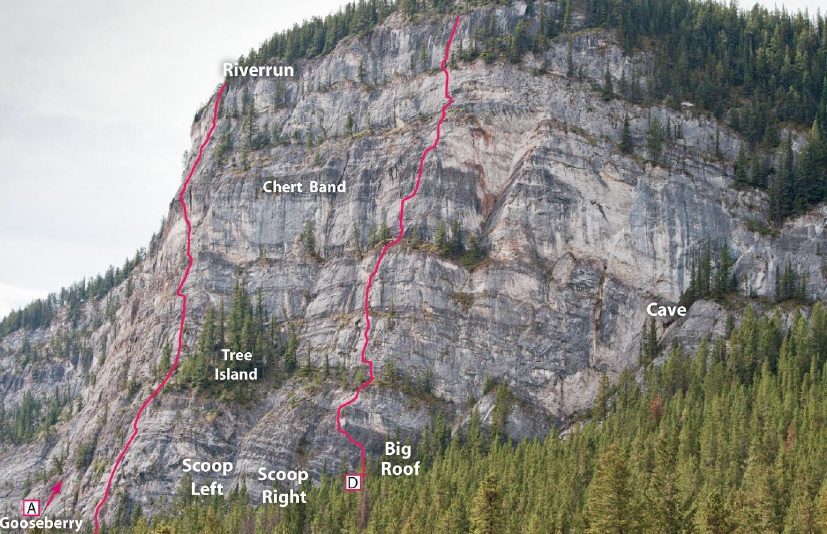New Nine-Pitch Banff Sport Route is River Run 5.10

Chris Perry has been establishing routes in the Canadian Rockies for five decades. Some of his first new routes were in the Ghost in the 1970s and they were run-out and bold trad lines.
Over the past few years, Perry has added some of the Bow Valley’s most-loved sport routes, such as Ballista 5.10+ on Tunnel Mountain and Tall Storey 5.11c in Echo Canyon.
Perry spent the last few seasons cleaning and developing a new nine-pitch 5.10+ on Tunnel Mountain he called River Run He made the first ascent in August 2016 with Brian Wyvill.
Perry’s description is: This nine-pitch route is the result of the latest excavation/construction project on the east face of Tunnel Mountain. The climb follows the obvious prow on that side of the mountain and has some excellent climbing on generally good rock. It is a sport route, completely equipped and with a 30m rappel route.

At least 15 QDs are required and some longer slings are useful. The route has been cleaned extensively but there seems to be an endless supply of loose rock, particularly at the ledges. Watch out for people below who may be traversing along the base towards the Gooseberry area (the lower trail is recommended).
The climb itself follows a diagonal line and climbing parties lower down are not generally in the line of fire. The rappel descent route, however, is a different matter – see below. The first two pitches are worth doing in their own right as a shorter climb. An easier start is currently under construction (fixed ropes) starting in a large bay about 20 m further left.
Start: Hike up towards The Scoop and when the trail reaches the cliff, continue left along the base instead of going right and up towards The Scoop. Go left past a small rib and the start is about 10 m further on, below a row of bolts leading up to a large, rounded band of overhangs.
1. 30 m, 5.10c or 10d. (15 bolts) Climb up and left easily at first and then make a tricky move right past the third bolt to reach a good foot-ledge. Continue up to the roof and lean out on rounded holds at first and then using a good finger-crack to reach a big hold over the top and slightly to the left. Reach across to another good hold and pull up (10c or 10d) into a shallow scoop. Climb the steep wall above and go over the bulge on good holds into a small bay. Make a couple of moves up a small corner and then exit left onto the face (hidden bolt). Continue more easily up a shattered wall and onto slabs above. The station is at a grassy ledge a short distance higher.
2. 30 m, 5.10a/b. (12 bolts) Move up to a small ledge just left of the tree and climb the slabby wall above on great rock, angling slightly left. Slightly harder climbing near the top leads to the station at a small ledge.
3. 30 m, 5.7. (6 bolts) Step up left to a ledge below a short groove and climb the left arête on excellent holds to broken ground and a left-slanting corner. Climb the slab left of the corner past 3 three bolts to more broken ground and a bolt at a small step. Scramble up to a station at the next rock band.
4. 20 m, 5.8. (7 bolts) Move up to a small roof and undercling using the crack beneath it to reach good holds above. Continue up the slabby wall past a balancy section to a shallow corner which leads to the next station at a long ledge.
5. 30 m, 5.9. (13 bolts) Climb the steepening wall above on good holds at first and then with more difficulty higher up to reach a line of overhangs. Traverse left, staying low, to gain a ledge at the left end of the overhangs at the base of a long, right-facing corner. Climb the corner (loose higher up) to a station on the left where the wall steepens.
6. 20 m, 5.10b. (6 bolts) Climb up and left from the belay and traverse around a small rib (bolt) into a bay below a rotten overhang. Move up past a bolt into a steep bridging position, reach up high on the left for a small, hidden slot, and then pull up using small incuts on each side of a bulging promontory to gain a good flat hold at its top. Climb up into the groove above and continue to a small, semi-hanging station on the left.
7. 30 m, 5.10a/b. (13 bolts) Follow the ramp above the belay on generally good holds, but with a few difficult sections, until forced out left and then up to a small “cave” below the final bulge. Move up left and find a small layaway for the right hand, crank up to reach small chert edges above and pull over the bulge to better holds. Continue more easily up and left to a good ledge below the lower-angled upper face.
8. 30 m, 5.9. (12 bolts) Climb the slabby wall above on good sloping holds towards a large, undercut flake on the left. Move up past the right side of the flake and step left above it onto small ledges. Difficult moves on the right lead to easier ground and a series of short corners in the wall above. Stay left of blocks near the top to reach the station at a long, horizontal ledge.
9. 15 m, 5.8. (5 bolts) Climb up into the corner above the belay and follow it past a bulge with interesting holds (fossilized sponges?) to a tree with a chain around it at the top.


